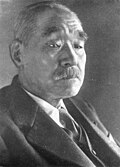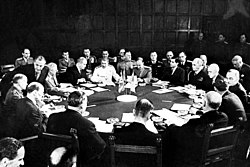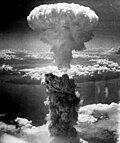Surrender of Japan

The surrender of Imperial Japan was announced by Japanese Emperor Hirohito on August 15 and formally signed on September 2, 1945. This ended World War II.
By the end of July 1945, the Imperial Japanese Navy (IJN) was not able to carry major operations and an Allied invasion of Japan was near.
Together with the United Kingdom and China, the United States called for the unconditional surrender of the Japanese armed forces in the Potsdam Declaration on July 26, 1945.
A key factor in Japan's surrender were the atomic bombings of Hiroshima and Nagasaki.[1]
Surrender Of Japan Media
Representatives of the Empire of Japan stand aboard USS Missouri prior to signing of the Instrument of Surrender
The rebuilt battlecruiser Haruna sank at her moorings in the naval base of Kure on 24 July during a series of bombings
The Kantarō Suzuki Cabinet in June 1945
As prime minister, Admiral Kantarō Suzuki headed the Japanese government in the final months of the war
Foreign Minister Shigenori Tōgō
A session of the Potsdam Conference – those pictured include Clement Attlee, Ernest Bevin, Vyacheslav Molotov, Joseph Stalin, William D. Leahy, James F. Byrnes, and Harry S. Truman.
Atomic bombing of Nagasaki
References
- ↑ Hasegawa, Tsuyoshi (August 1, 2007). "The Atomic Bombs and the Soviet Invasion: What Drove Japan's Decision to Surrender?". The Asia-Pacific Journal. 5 (8). – Article ID 2501 – PDF








